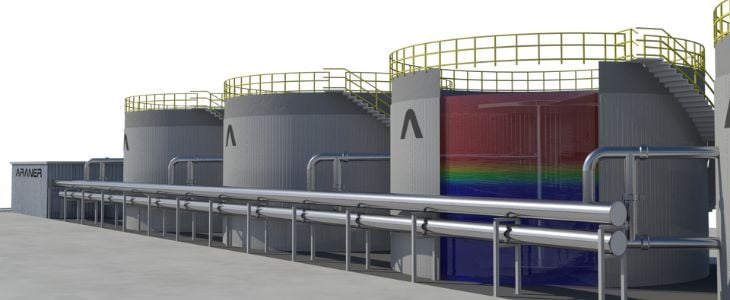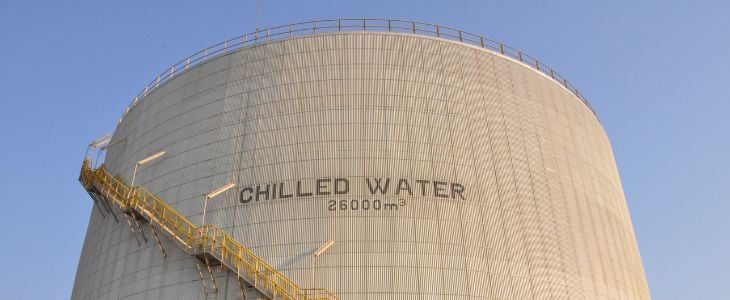The thermal energy storage system technology is pushing the way forward towards decarbonization in heating and cooling. Paired up with district energy structures, the right thermal storage tank allows developers to design more efficient district heating and district cooling while implementing renewable energies as sources.
What is thermal energy, why does it need to be stored and how is this technology helping in the decarbonization of cities? Find out in our brief guide about thermal energy storage.
What is a thermal energy storage system
To understand a thermal energy storage system it’s perhaps necessary to first address what is thermal energy.
Thermal energy is the energy that regulates temperature in a system. Thermal energy transfers between different systems in different ways, generating heat, a process that is researched by thermodynamics.
The need for thermal thermal storage of energy arises precisely because of this transfer of energy: if thermal energy storage is obtained through a thermal storage tank, then inefficiencies such as heat losses can be eliminated.
This, in turn, translates into not having to generate as much energy, which results into great cost savings as well as a minimized environmental impact.
Up until now, most processes in need of thermal energy weren’t storing it for a later reuse: they produced it and accepted thermal energy waste. However, with an increased focus on the environmental impact of energy production, the quest for technologies that would improve this issue intensified.
This is where the thermal energy storage system comes in. This system is in charge of accumulating and storing thermal energy so that it’s possible to use it later when needed.
Through the use of a thermal storage tank, companies have access to a number of benefits:
- Higher efficiency
- Reduced operational costs
- Capacity to integrate renewable energies such as solar and wind power
- Heating and cooling waste is eliminated. Extra energy is stored until there’s real demand for it, providing a balance for seasonal demand, eliminating scenarios such as issues with energy availability.
- Part of global efforts towards meeting energy requirements for smart cities
These advantages have pushed the thermal energy storage system demand, which is expected to grow from 234 gigawatt hour (GWh) of installed capacity in 2019 to over 800 GWh in the next 10 years, reaching a market value of USD 28 billion over the decade, according to figures published by Irena.
Current possibilities for a thermal energy storage system
- Stratified water storage tank: this model for a thermal energy storage system works by storing two volumes of water separated thanks to a stable density gradient. Charging energy means the bottom diffuser introduces cold water, while the warm water is eliminated from the top of the tank. On the other hand, the discharging mode means cold water is eliminated through the bottom diffuser while warm water goes back to the top position.
- Ice thermal thermal storage tank: in this case, thermal energy is stored in ice through different technologies. Tools such as chillers and refrigerants are also employed, as well as different ice storage technologies including an ice harvester, internal melt-on-coil, and external melt-on-coil and encapsulated ice.

Essential keys for implementing a thermal energy storage system in district energy models
The move towards sustainability in district energy models has meant the ability to shift from fossil fuel burning to using renewable, less pollutant sources. This, in turn, has been facilitated by the use of efficient thermal energy storage systems.
Applied to district heating and district cooling, a TES system means production and consumption of thermal energy no longer needs to be simultaneous, leading to great efficiencies.
As increasing restrictions around CO2 emissions arise, district energy models that employ thermal energy storage systems help moving towards a greener future.
But, how is a thermal energy storage system implemented in a district heating and district cooling structure? The following are two of the keys to take into account:
The design process
An adequate design process for a thermal energy storage system means it adjusts to the specific needs of each structure.
As such, the following elements are explored, among others:
- Space availability
- Chiller/heat pump efficiency and operating conditions
- Environmental and climatic conditions at the project’s location
- Heating and cooling demand, analyzed for a complete year
- Potential strategies for system control
- Expected occupancy in buildings
- Partial storage or full storage scenarios are considered
- Computational fluid dynamics are simulated for a simulation for testing the thermal energy storage system.

Types of tanks
-
Above-ground
When installing a thermal energy storage system, cylindrical welded steel tanks are often preferred. Design and construction for this option are streamlined, and a minimized maintenance is guaranteed.
In order to achieve a pleasant environment in terms of architecture and minimize the visual impact of the above-ground approach to a thermal storage tank, a number of disciplines are integrated, including creative landscaping, cladding, lighting and surface textures.
-
Underground thermal energy storage system
Sometimes above-ground structures are not possible. This is particularly true when district energy systems are located in cities. In such scenarios, it’s possible to resort to underground thermal energy storage systems.
Typically located in buildings’ basements, these present specific challenges in terms of thermal storage tank design. However, outstanding examples for this model of energy storage have been already generated, such as the TES tank of Jordan District Cooling Plant, which presents a 70,000 m3.
-
Partially-buried tanks
An intermediate and perhaps more flexible solution, its suitability should be studied on a case by case scenario.
The Al Ashghal Data Center Case Study in Qatar provides a successful example of a partially-buried thermal energy storage system, where a 2.5 m height buried and 2.5 m height above-ground approach was applied.
At Araner, we work to develop efficient district heating and district cooling solutions and, as part of our efforts, we’ve developed state-of-the-art thermal storage tanks.
Our thermal energy storage systems are thus part of our effort to help companies and developers attain increased cost-efficiency as well as minimizing the environmental impact of their structures.
Want to learn more about thermal energy storage systems and how they’re pushing forward in achieving efficiency and sustainability?
Download our free ebook about our Al Ashghal case study or get in touch with us to discover our TES solutions.










